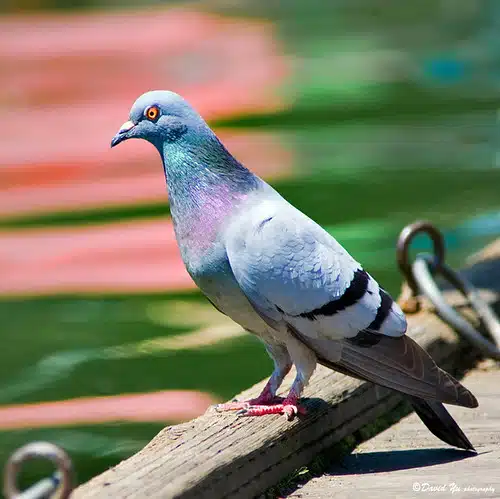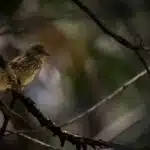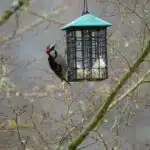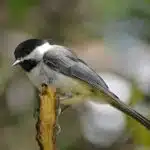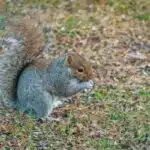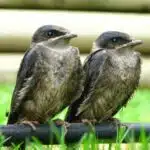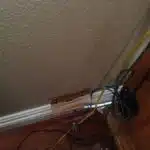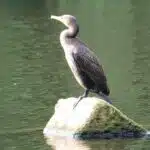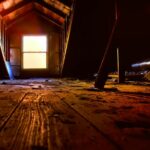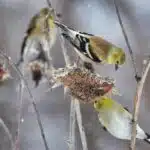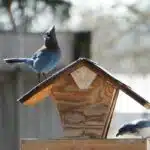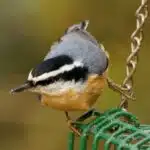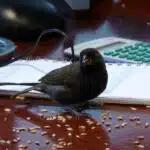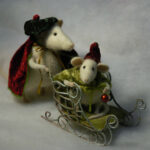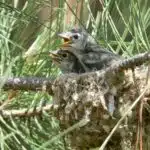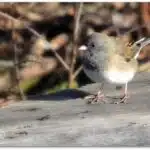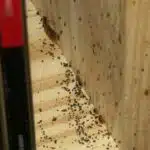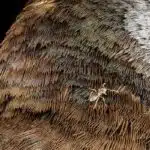Pigeons are a common sight in urban areas, often seen perched on buildings and scavenging for food scraps. While they may seem harmless, these birds can cause significant damage to buildings and pose health risks to humans. As such, it’s important to have effective methods for getting rid of pigeons.
As an avian control specialist, I have encountered numerous cases where pigeons have caused serious problems for property owners. From damaging roofs and gutters with their droppings to transmitting diseases like salmonella and histoplasmosis, these birds can be a nuisance that cannot be ignored. In this article, I will provide expert advice on how to effectively get rid of pigeons using humane methods that will not harm the birds or other wildlife in the area.
Understanding The Behavior Of Pigeons
While pigeons may seem like harmless birds, they can quickly become a nuisance when they decide to take up residence in or around your property. Before taking any measures to get rid of these birds, it’s important to understand their behavior. Pigeons are social animals and tend to flock together in large groups. They have a complex social structure that is based on hierarchy, with dominant birds often leading the group.
Pigeons are also known for their unique mating habits. Unlike other birds that mate for life, pigeons will often mate with multiple partners during a breeding season. The male will typically court the female by puffing up his chest feathers and cooing loudly. Once the pair has mated, they will work together to build a nest out of twigs, grasses, and other materials.
Communication is key for pigeons when it comes to survival and reproduction. They use both vocalizations such as cooing and body language to communicate with each other. For example, head bobbing can be a sign of aggression or dominance, while preening can be seen as a sign of affection between mates. Understanding these behaviors can help you better identify when there is a pigeon infestation on your property and how best to deal with it.
Moving forward into the next section on identifying signs of an infestation, it’s important to keep in mind that pigeon behavior plays a significant role in determining whether or not you need to take action against them. By recognizing specific behaviors associated with pigeon infestations and understanding what those behaviors mean, you’ll be able to take proactive steps towards solving the problem at hand without causing harm to yourself or others in the process.
Identifying The Signs Of A Pigeon Infestation
- Pigeon droppings are a telltale sign of an infestation as they are often found in clusters on windowsills and ledges.
- Infestations can also be identified by examining potential nesting sites such as ledges, roofs, and attics for nesting materials.
- Pigeons create nests using twigs and other materials that can be found in the vicinity of the infestation.
- Additionally, the presence of pigeons in large numbers can be an indication of a serious infestation.
Identifying Droppings
The first step in identifying a pigeon infestation is to examine the droppings. Pigeon droppings are usually gray or white, and may range from small to large in size. The texture of the droppings can also provide important clues about the severity of the infestation. Fresh droppings will be soft and moist, while older droppings will be dry and crumbly.
It is important to note that pigeon droppings can pose a significant health risk to humans and pets. They contain a variety of bacteria and viruses that can cause respiratory problems, skin irritation, and other health issues. Therefore, it is essential to wear protective gear when examining or cleaning up pigeon droppings. Proper cleaning methods should also be utilized, including using water and disinfectant to sanitize affected areas.
By analyzing the location of pigeon droppings, it is possible to identify nesting sites and food sources. Pigeons tend to roost in high places such as rooftops, ledges, and balconies. They are also attracted to areas with easy access to food, such as garbage cans or outdoor dining areas. By identifying these locations through analysis of pigeon droppings, it is possible to develop an effective pest control strategy that targets both nesting sites and food sources.
Please note that identifying the signs of a pigeon infestation involves more than just examining the droppings. Other indicators include the presence of feathers or nests, unusual bird activity around your property, and cooing sounds coming from nearby trees or buildings. It is important to seek professional help if you suspect a pigeon infestation on your property.
Identifying Nesting Areas
Identifying the nesting areas of pigeons is crucial in developing an effective pest control strategy. Pigeons are social birds that tend to roost in groups, and they have specific nesting habits that can be observed through careful analysis of their behavior patterns. In general, pigeons prefer high places such as rooftops, ledges, and balconies for nesting. They also look for sheltered areas where their nests will be protected from the elements.
In addition to examining the location of pigeon droppings, other signs of a possible nesting site include the presence of feathers or twigs. Pigeons build their nests using a variety of materials including sticks, grasses, and even trash. These nests can often be found on ledges or under eaves where they are protected from wind and rain. Another indicator of a potential nest is unusual bird activity around your property. If you notice multiple pigeons flying in and out of a certain area, it is likely that they have established a nest nearby.
Once you have identified the nesting areas of pigeons on your property, it is important to take action to prevent further infestation. This may involve sealing off access points such as gaps in walls or windowsills where pigeons can enter. It may also require removing any food sources that attract these birds, such as outdoor dining areas or uncovered garbage cans. By taking these steps and working with a pest control professional if necessary, you can effectively manage a pigeon infestation and protect your property from damage caused by these birds.
Assessing The Severity Of The Problem
Identifying the signs of a pigeon infestation is the first step in addressing the issue. Once you have seen evidence of droppings, nests, or birds roosting on your property, it is important to assess the severity of the problem. The amount of damage caused by pigeons can vary greatly depending on factors such as location, population size, and duration of the infestation.
Assessing the severity of a pigeon problem involves more than just counting birds. A professional assessment should include a cost analysis that takes into account potential damage to property and structures as well as any health risks posed by pigeons. Pigeon droppings can carry diseases and cause respiratory problems, making them a serious health hazard for humans.
A thorough assessment will help determine the best course of action for getting rid of pigeons on your property. With information about the extent of the infestation and associated costs and risks, you can make an informed decision about which methods to use for control and prevention. In the next section, we will discuss developing a plan of action based on your assessment results.
Developing A Plan Of Action
As the old adage goes, “An ounce of prevention is worth a pound of cure.” This applies to getting rid of pigeons as well. The first step in developing a plan of action is to assess the situation and identify why the pigeons are attracted to the area. Is it food, water, or shelter? Once you have identified the problem areas, you can begin to create a timeline for addressing them.
Creating a timeline is critical for successfully getting rid of pigeons. It helps ensure that all necessary steps are taken at the right time and in the correct sequence. For example, if you need to remove food sources, you may want to do this before attempting any other deterrents. You should also consider seeking help from experts who have experience with avian control. They can provide valuable insight into what methods work best and what potential pitfalls to avoid.
In summary, creating a plan of action for getting rid of pigeons requires assessing the situation and identifying problem areas, creating a timeline for addressing these areas, and seeking help from experts when needed. The next step in implementing non-lethal deterrents will be discussed in detail in the subsequent section.
Implementing Non-Lethal Deterrents
Having developed a plan of action, the next step is to implement non-lethal deterrents to keep pigeons away. These deterrents are designed to make the environment inhospitable for pigeons, without harming them. There are many different types of non-lethal deterrents available, each with its own advantages and disadvantages.
One effective way to deter pigeons is through community involvement. By educating the public about the dangers associated with feeding pigeons and providing alternative food sources for them, we can reduce the pigeon population in a humane way. Additionally, we can work with property owners to remove any potential nesting spots or food sources that may attract pigeons. This type of collaborative effort not only benefits the community but also promotes ethical considerations towards animal control.
Another approach is to install spikes and netting in areas where pigeons tend to roost or nest. Spikes are typically placed on ledges, roofs, and other flat surfaces where pigeons would normally perch. Netting can be used to cover large areas like courtyards or balconies where pigeons gather in large numbers. Both options are effective at deterring pigeons from landing or roosting in these areas.
- Four items that could be included in a bullet point list:
- Use visual deterrents such as predator decoys or reflective surfaces.
- Install motion-activated water sprayers that will scare off pigeons.
- Utilize sound-based deterrents like ultrasonic devices or recordings of predator calls.
- Consider hiring professional avian control specialists who have experience dealing with pigeon infestations.
In conclusion, implementing non-lethal deterrents requires careful planning and collaboration between various stakeholders within the community. By utilizing a combination of techniques like spikes, netting, visual and sound-based deterrents, we can create an environment that is less hospitable to pigeons while promoting ethical considerations towards animal control. The next section will focus on the installation process of spikes and netting, which are among some of the most effective non-lethal deterrents for keeping pigeons away.
Installing Spikes And Netting
Installing spikes and netting is one of the most effective ways to get rid of pigeons. It is a humane method that prevents the birds from landing or roosting on ledges, roofs, and other surfaces where they cause damage and spread diseases. Spikes are made of stainless steel and come in different sizes to fit various surfaces. They create an uneven surface that makes it uncomfortable for pigeons to land, forcing them to seek shelter elsewhere.
Netting works by preventing pigeons from accessing a particular area altogether. The nets are made of durable materials like polyethylene or nylon and can be customized to fit any structure. They are particularly useful for large areas like warehouses, bridges, and stadiums. Netting is also effective in preventing pigeons from nesting in attics or other enclosed spaces.
The cost of installation for spikes and netting varies depending on the size of the area and the complexity of the job. However, it is a long-term investment that pays off in terms of reduced maintenance costs and improved health and safety conditions. Spikes can last up to 10 years before needing replacement, while netting can last even longer with proper maintenance. Moreover, spikes and netting do not require any ongoing maintenance aside from periodic cleaning.
Transition: While spikes and netting are effective physical barriers against pigeon infestations, there are other methods available that use sound and visual repellents.
Using Sound And Visual Repellents
Installing spikes and netting can be an effective way to prevent pigeons from roosting and nesting on buildings. However, some property owners may prefer more humane methods that do not harm the birds. In such cases, sound and visual repellents can be a viable option.
Sound repellent effectiveness varies depending on the specific product used and the frequency of use. Some devices emit high-pitched sounds that are irritating to pigeons, while others play recordings of predator sounds or distress calls. These methods can be effective in deterring pigeons from an area but may require consistent use to maintain their effectiveness.
Visual repellent options include fake owls or hawks, reflective tape, and scare balloons. These items create the illusion of a predator or danger in the area, which can deter pigeons from roosting or nesting nearby. However, like sound repellents, consistency is key to maintaining their effectiveness.
Incorporating sound and visual repellents into a comprehensive pigeon control plan can be an effective way to deter these birds without causing harm. In the next section, we will discuss applying repellent gels and sprays as another option for managing pigeon populations on your property.
Applying Repellent Gels And Sprays
Applying repellent gels and sprays can be an effective method of deterring pigeons from your property. However, it is important to choose the right product for your specific situation. There are many different types of repellents on the market, including those that use chemical agents, natural ingredients, or physical barriers. It is essential to research each type and read customer reviews before making a purchase.
When using repellent gels and sprays, it is also important to avoid harm to other wildlife in the area. Some products may be harmful to birds or other animals that come into contact with them. To prevent unintended consequences, it is best to consult with a pest control expert or avian control specialist before applying any type of repellent.
Overall, applying repellent gels and sprays can be an effective solution for getting rid of pigeons. Choosing the right product and using it safely can help ensure success in deterring unwanted birds from your property.
Transition: Now that you have learned about applying repellent gels and sprays, let’s explore another method for pigeon control: removing food sources and nesting materials.
Removing Food Sources And Nesting Materials
While repellent gels and sprays are effective in deterring pigeons from landing on certain surfaces, they may not be sufficient for getting rid of them entirely. One theory suggests that creating barriers and modifying buildings can prevent pigeons from roosting or nesting in areas they frequently inhabit. By making it difficult for these birds to land or perch, we can discourage them from staying in the area.
One way to create barriers is by using netting or wiring around ledges, roofs, and balconies where pigeons tend to congregate. These materials make it difficult for the birds to find a comfortable spot to nest, and they will eventually move on to another location. Additionally, modifying buildings by removing any potential nesting sites such as cracks or crevices can also discourage pigeons from returning.
Another strategy is to use decoys or fake predators such as plastic owls or hawks. These visual deterrents trick the pigeons into thinking there is a predator nearby, causing them to flee the area. However, it’s important to move the decoys regularly so that they don’t become familiar with their surroundings and lose their effectiveness.
To completely get rid of pigeons, it’s crucial to close off entry points that allow them access into the building. This includes sealing gaps around windows, doors, and vents. By eliminating any possible entryways and creating an inhospitable environment for these birds, we can effectively prevent them from returning to our properties.
Closing Off Entry Points
- Identifying entry points for pigeons is the first step in preventing their presence; these can be identified by examining the structure of a building and noticing any possible openings.
- Blocking entry points with barriers such as fine-mesh netting or bird spikes can be effective in deterring pigeons from entering.
- Monitoring pigeon activity is also important; this can involve tracking their movements and noting down any nesting or roosting sites.
- It is important to remember that pigeons are resilient and may find other entry points if one is blocked, so vigilance is essential when managing their presence.
- Regularly inspecting the structure of a building can help to ensure that entry points are identified and dealt with swiftly.
- Utilising the services of a pest control expert or avian control specialist may be necessary to ensure that all entry points are identified and dealt with appropriately.
Identifying Entry Points
Identifying entry points is crucial in closing off access for pigeons. Common entry points include gaps in roofing, vents and ducts leading to attics or crawl spaces, and openings in walls. It is important to thoroughly inspect the building for potential entry points, as pigeons can enter through small gaps or cracks.
Preventing future entry is key after identifying current entry points. This can be achieved by sealing any gaps or holes with appropriate materials such as caulking or wire mesh. Additionally, installing bird netting or spikes can prevent pigeons from landing on ledges or other surfaces near entry points.
Regular maintenance of the building’s exterior can also help prevent future entry by removing any potential nesting materials and keeping vegetation trimmed back from the building. By identifying and closing off current entry points while taking steps to prevent future access, a pest control specialist can effectively get rid of pigeons without harming them or causing damage to the structure of the building.
Blocking Entry Points
Prevention methods are crucial in controlling the pigeon population and maintaining a clean and safe environment. One effective way to achieve this is by blocking entry points, which involves identifying gaps or holes that pigeons can use to enter the building. Common entry points include gaps in roofing, vents, ducts leading to attics or crawl spaces, and openings in walls. These areas should be thoroughly inspected for potential access points as pigeons can enter through small cracks or gaps.
Blocking entry points is an essential step in preventing future infestations of pigeons. DIY solutions such as sealing any gaps or holes with appropriate materials like caulking or wire mesh can help prevent future access. Bird netting or spikes can also be installed to prevent these birds from landing on ledges or other surfaces near entry points. Regular maintenance of the building’s exterior is necessary to reduce potential nesting materials and keep vegetation trimmed back from the structure.
The process of blocking entry points can be challenging without professional assistance. Pest control specialists have a wealth of knowledge and experience in dealing with bird infestations and blocking entry points effectively. They employ a range of modern techniques, tools, and equipment that ensure a comprehensive solution to pigeon problems. In conclusion, preventative measures such as blocking entry points coupled with regular maintenance are essential for controlling pesky pigeon populations effectively while maintaining a healthy environment around buildings.
Monitoring Pigeon Activity
Preventing pigeons from entering a building is crucial in controlling their population and reducing the risks associated with their presence. Once all entry points are blocked, it’s essential to monitor pigeon activity to ensure that they do not find new ways to access the building. Pigeon behavior observation is an effective way of tracking movements and identifying any potential threats.
One way of monitoring pigeon activity is by observing their feeding habits. Pigeons tend to congregate around areas where food is available, such as garbage cans or outdoor dining areas. By keeping these areas clean and free from food debris, property owners can reduce pigeon populations significantly. Additionally, observing when pigeons are most active can help determine optimal times for installing preventative measures like bird spikes or netting.
Another method of monitoring pigeon activity involves tracking pigeon droppings. Pigeon excrement is highly acidic and can cause damage to buildings’ exterior surfaces, including roofs and walls. Regularly checking for droppings can help identify areas where pigeons are roosting or nesting, allowing property owners to take appropriate action before infestations become severe. Additionally, tracking droppings can help determine if preventative measures installed earlier are working effectively.
In conclusion, monitoring pigeon activity is critical in maintaining a pest-free environment after blocking entry points. Observing feeding habits and tracking droppings are two effective methods of monitoring pigeon behavior that helps identify new infestations or control existing ones better. Property owners should always be proactive in preventing infestations by installing preventative measures and regularly maintaining the area around their buildings to keep them clean and uninviting to pigeons.
Trapping And Releasing Pigeons
Trapping and releasing pigeons is one of the most humane methods of pigeon control. However, it requires careful planning and execution to ensure that the process is effective and ethical. Before starting the trapping process, it is essential to identify the areas where pigeons are nesting or roosting. This will help in determining the number of traps needed for successful trapping.
Once you have identified the areas where pigeons are present, you can set up your traps in those locations. It is important to use live traps as they are more humane and do not harm the bird in any way. Once a pigeon has been trapped, it should be immediately released as keeping them in captivity for a long period can cause stress and other health issues.
Ethical considerations should always be taken into account when trapping and releasing pigeons. It is important to release them far away from human habitation, traffic, and other hazards that could endanger their lives. The releasing process should also be done carefully to avoid injuring the bird during its release back into its natural habitat. By following these steps, you can successfully trap and release pigeons without causing any harm or distress to them.
Transition: While trapping and releasing pigeons can be an effective solution in some cases, it may not be suitable for all situations. If you find yourself struggling with pigeon control even after attempting this method, seeking professional help may be necessary.
Seeking Professional Help
Imagine you have a persistent headache that refuses to go away despite taking over-the-counter painkillers. You may choose to wait it out, hoping it will eventually subside. However, if the headache persists or worsens, seeking professional medical help becomes necessary. Similarly, when faced with a pigeon infestation problem, relying on DIY methods may not always yield satisfactory results. Seeking expert advice from pest control specialists can be beneficial in resolving the issue.
Cost of professional services should not discourage you from consulting avian control specialists. While there may be an initial expense involved in hiring professionals, it is essential to consider the long-term benefits of their services. Professionals use humane methods to remove pigeons and prevent them from returning, which may save you money in the long run by avoiding recurring expenses associated with DIY methods.
Benefits of seeking expert advice go beyond effective pigeon removal and prevention techniques. Avian control specialists can assess your property’s unique situation and provide customized solutions that address any underlying factors leading to the infestation problem. Additionally, they can educate you on how to maintain a pigeon-free environment by incorporating preventive measures into your property’s design and landscaping.
Consulting professional avian control specialists can be instrumental in eliminating your pigeon infestation problems permanently. The cost of their services should not deter you from considering their expertise in creating a safe and healthy environment for yourself and others around you. By working together with experts’ help, maintaining a pigeon-free environment is achievable through simple yet effective approaches such as regular cleaning practices and implementing bird barriers.
Maintaining A Pigeon-Free Environment
Seeking professional help is a great way to get rid of pigeons. However, it’s essential to maintain a pigeon-free environment after the experts have done their job. This section will provide some tips on how to keep your property free from pesky pigeons.
Maintaining cleanliness is crucial in preventing pigeons from roosting around your property. Pigeons are attracted to food scraps and other debris, so keeping the area clean can help deter them. Food should be stored in sealed containers, and any spills or crumbs should be cleaned up immediately. Regularly sweeping and hosing down outdoor areas can also discourage birds from settling in.
Using scare tactics is another effective way to keep pigeons away. Visual deterrents such as decoys, flashing lights or reflective surfaces can trick the birds into thinking there is danger nearby. Loud noises such as sirens or clanging pots and pans can also startle them away. If you’re using a scare tactic, it’s important to change it up regularly as pigeons can become accustomed to one method over time.
In summary, maintaining cleanliness and using scare tactics are two simple ways to keep pigeons at bay after seeking professional help for removal. By implementing these measures, you’ll reduce the likelihood of future infestations and lessen the need for repeated interventions. Educating others on pigeon control is next, so they too can benefit from these tips and tricks.
Educating Others On Pigeon Control
To effectively control pigeon populations, it is important to educate others on the methods that work. Sharing experiences with fellow citizens can help spread awareness and promote effective pigeon control practices. By teaching others about the harmful effects of pigeons and the importance of controlling their population, we can create a more informed and proactive community.
Effective DIY methods are an important aspect of pigeon control. One such method is exclusion netting, which involves covering areas where pigeons tend to roost or nest with a durable netting material. This prevents them from accessing these areas and discourages them from returning in the future. Another useful DIY method is bird spikes, which are placed on ledges, roofs, and other surfaces to prevent pigeons from landing.
In addition to exclusion methods, it is also important to regularly monitor the effectiveness of your pigeon control efforts. This can be done by observing whether or not pigeon activity has decreased in areas where you have implemented your chosen methods. By staying vigilant and adapting your approach as needed, you can successfully keep pigeons at bay and maintain a healthy environment for yourself and others.
- Installing decoys or predator models
- Implementing sound deterrents
- Changing landscaping features that attract pigeons , such as reducing food sources and eliminating standing water. This can include properly disposing of garbage, covering compost bins, and repairing any leaks or drainage issues. Additionally, using bird netting or spikes on ledges and other areas where pigeons roost can also be effective in deterring them from nesting. Regular cleaning and maintenance can also help keep pigeons away, such as removing bird droppings and disinfecting areas where they congregate. Finally, it may be necessary to work with a professional pest control company to help implement more aggressive measures if other methods prove ineffective.
Monitoring The Effectiveness Of Your Methods
Measuring success is an important aspect of any pest control program, including avian control. After implementing various methods to get rid of pigeons, it is necessary to track progress and evaluate the effectiveness of the chosen method. This can be done by monitoring pigeon activity in the area, as well as the number of bird droppings and damage caused by their presence.
One way to track progress is through regular inspections of the area. This can involve checking for signs of pigeon activity such as nests, feathers, and droppings. It is also important to assess any damage caused by pigeons, such as damaged roofing or buildings. By keeping records of these inspections over time, it is possible to see if there has been a decrease in pigeon activity and associated damage.
Another way to measure success is through feedback from others in the area. This could include residents or business owners who have noticed a decrease in pigeon activity since the implementation of avian control methods. Their input can provide valuable insights into the effectiveness of different methods and help adjust strategies accordingly.
Tracking progress and measuring success are important steps in any pest control program, including avian control for pigeons. By regularly monitoring pigeon activity and seeking feedback from those in the affected area, it is possible to determine which methods are most effective in reducing pigeon presence and associated damage.
Conclusion
Understanding the behavior of pigeons is key in getting rid of these pesky birds. Identifying the signs of a pigeon infestation and assessing the severity of the problem are crucial steps in developing a plan of action. Non-lethal deterrents such as netting, spikes, and repellents can be effective, but seeking professional help may be necessary for more severe cases.
Maintaining a pigeon-free environment requires ongoing efforts such as regular cleaning and maintenance. Educating others on pigeon control can also help prevent future infestations. Monitoring the effectiveness of your methods is important to ensure long-term success.
In conclusion, as pest control experts or avian control specialists, we understand the frustration that comes with dealing with pigeons. While it may seem daunting at first, following these steps can lead to a successful outcome. Remember, “prevention is better than cure.” Taking proactive measures to prevent infestations from occurring in the first place will save you time and money in the long run.
Image Credits
- “pigeon” by davidyuweb (featured)

